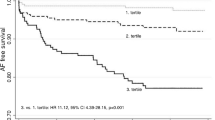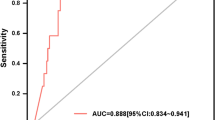Abstract
Background
New-onset atrial fibrillation (NOAF), a common complication of acute ST-segment elevation myocardial infarction (STEMI), is associated with a poor prognosis. Several clinical and laboratory parameters are reported to be associated with NOAF in patients with STEMI. The aim of the present study was to evaluate the predictive value of plasma B‑type natriuretic peptide (BNP) levels for NOAF development and long-term prognosis in STEMI patients undergoing primary percutaneous coronary intervention (pPCI).
Patients and methods
We retrospectively enrolled 1,928 patients with STEMI who underwent pPCI. After applying exclusion criteria, 1,057 patients were retained in the final study population. Patients with NOAF were compared with patients without NOAF in the entire study population and in a matched group.
Results
Patients with NOAF had a significantly higher average plasma BNP level (161 pg/ml, range: 72.3–432) than patients without NOAF in the study population (70.7 pg/ml, range: 70–129; p < 0.001) and in the matched group (104.6 pg/ml, range: 47.2–234.5; p = 0.014). Furthermore, the plasma BNP level was found to be an independent predictor of NOAF development (odds ratio [OR]: 1.003; 95% confidence interval [CI]: 1.000–1.005; p = 0.034) and mortality in the long-term follow-up (OR: 1.004; 95% CI: 1.002–1.006; p < 0.001).
Conclusion
The present study found that a high plasma BNP level was significantly associated with NOAF development in STEMI patients, and was an independent predictor of NOAF development and all-cause mortality during long-term follow-up, regardless of other NOAF risk factors.
Zusammenfassung
Hintergrund
Neu aufgetretenes Vorhofflimmern („new-onset atrial fibrillation“, NOAF), eine häufige Komplikation des akuten ST-Strecken-Hebungs-Infarkts (STEMI), geht mit einer schlechten Prognose einher. Verschiedene klinische und Laborparameter sollen mit NOAF bei STEMI-Patienten in Zusammenhang stehen. Ziel der vorliegenden Studie war es, den prädiktiven Wert der Werte für BNP („B-type natriuretic peptide“) für das Auftreten von NOAF und die Langzeitprognose bei STEMI-Patienten nach primärer perkutaner Koronarintervention (pPCI) zu untersuchen.
Patienten und Methoden
Retrospektiv wurden 1928 Patienten mit STEMI und nach pPCI in die Studie aufgenommen. Nach Anwendung der Ausschlusskriterien verblieben letztlich 1057 Patienten in der Studienpopulation. Dabei wurden in der gesamten Studienpopulation und einer entsprechend ausgewählten Gruppe Patienten mit NOAF im Vergleich zu Patienten ohne NOAF betrachtet.
Ergebnisse
Die Patienten mit NOAF wiesen einen signifikant höheren durchschnittlichen Plasma-BNP-Wert auf (161 pg/ml, Spannbreite: 72,3–432) als Patienten ohne NOAF in der Studienpopulation (70,7 pg/ml, Spannbreite: 70–129; p < 0,001) und in der gematchten Gruppe (104,6 pg/ml, Spannbreite: 47,2–234,5; p = 0,014). Darüber hinaus stellte sich der Plasma-BNP-Wert als ein unabhängiger Prädiktor des Auftretens von NOAF (Odds Ratio, OR: 1,003; 95%-Konfidenzintervall, 95%-KI: 1,000–1,005; p = 0,034) und der Mortalität während der Langzeitnachbeobachtung heraus (OR: 1,004; 95%-KI: 1,002–1,006; p < 0,001).
Schlussfolgerung
In der vorliegenden Studie wurde festgestellt, dass ein hoher Plasma-BNP-Wert in signifikanter Weise mit dem Auftreten von NOAF bei STEMI-Patienten in Zusammenhang steht und sich als unabhängiger Prädiktor des Auftretens von NOAF und der Gesamtmortalität während der Langzeitnachbeobachtung, unabhängig von Risikofaktoren für NOAF, herausstellte.


Similar content being viewed by others
References
Schmitt J, Duray G, Gersh BJ, Hohnloser SH (2009) Atrial fibrillation in acute myocardial infarction: A systematic review of the incidence, clinical features and prognostic implications. Eur Heart J 30:1038–1045
Crenshaw BS, Ward SR, Granger CB et al (1997) Atrial fibrillation in the setting of acute myocardial infarction: the GUSTO-I experience. Global Utilization of Streptokinase and TPA for Occluded Coronary Arteries. J Am Coll Cardiol 30:406–413
Wong CK, White HD, Wilcox RG et al (2003) Significance of atrial fibrillation during acute myocardial infarction, and its current management: insights from the GUSTO-3 trial. Card Electrophysiol Rev 7:201–207
Kinjo K, Sato H, Sato H et al (2003) Prognostic significance of atrial fibrillation/atrial flutter in patients with acute myocardial infarction treated with percutaneous coronary intervention. Am J Cardiol 92:1150–1154
Gorenek B, Kudaiberdieva G (2012) Atrial fibrillation in acute ST elevation myocardial infarction: clinical and prognostic features. Curr Cardiol Rev 8:281–289
Waldecker B (1999) Atrial fibrillation in myocardial infarction complicated by heart failure: cause or consequence? Eur Heart J 20:710–712
Wiese S, Breyer T, Dragu A et al (2000) Gene expression of brain natriuretic peptide in isolated atrial and ventricular human myocardium: influence of angiotensin II and diastolic fiber length. Circulation 102:3074–3079
Maeda K, Tsutamoto T, Wada A et al (1998) Plasma brain natriuretic peptide as a biochemical marker of high left ventricular end-diastolic pressure in patients with symptomatic left ventricular dysfunction. Am Heart J 135:825–832
De Lemos JA, Morrow DA, Bentley JH et al (2001) The prognostic value of B‑type natriuretic peptide in patients with acute coronary syndromes. N Engl J Med 345:1014–1021
Garcia-Alvarez A, Sitges M, Delgado V et al (2009) Relation of plasma brain natriuretic peptide levels on admission for ST-elevation myocardial infarction to left ventricular end-diastolic volume six months later measured by both echocardiography and cardiac magnetic resonance. Am J Cardiol 104:878–882
Steg PG, James SK, Atar D et al (2012) ESC Guidelines for the management of acute myocardial infarction in patients presenting with ST-segment elevation. Eur Heart J 33:2569–2619
Gibson CM, Cannon CP, Daley WL et al (1996) TIMI frame count: a quantitative method of assessing coronary artery flow. Circulation 93:879–888
Camm AJ, Kirchhof P, Lip GY et al (2010) European Heart Rhythm Association, European Association for Cardio-Thoracic Surgery Guidelines for the management of atrial fibrillation: the Task Force for the Management of Atrial Fibrillation of the European Society of Cardiology (ESC). Eur Heart J 31:2369–2429
Lang RM, Bierig M, Devereux RB et al (2005) Recommendations for chamber quantification: a report from the American society of echocardiography’s guidelines and standards committee and the chamber quantification writing group, developed in conjunction with the European association of echocardiography, a branch of the European society of cardiology. J Am Soc Echocardiogr 18:1440–1463
Pizzetti F, Turazza FM, Franzosi MG et al (2001) GISSI-3 Investigators. Incidence and prognostic significance of atrial fibrillation in acute myocardial infarction: the GISSI-3 data. Heart 86:527–532
Watanabe H, Watanabe T, Sasaki S et al (2009) Close bidirectional relationship between chronic kidney disease and atrial fibrillation: the Niigata preventive medicine study. Am Heart J 158:629–636
Naccarelli GV, Varker H, Lin J et al (2009) Increasing prevalence of atrial fibrillation and flutter in the United States. Am J Cardiol 104:1534–1539
Perez MV, Wang PJ, Larson JC et al (2013) Risk factors for atrial fibrillation and their population burden in postmenopausal women: the Women’s Health Initiative Observational Study. Heart 99:1173–1178
Asanin M, Stankovic S, Mrdovic I et al (2012) B‑type natriuretic peptide predicts new-onset atrial fibrillation in patients with ST-segment elevation myocardial infarction treated by primary percutaneous coronary intervention. Peptides 35:74–77
Hwang HJ, Ha JW, Joung B et al (2011) Relation of inflammation and left atrial remodeling in atrial fibrillation occurring in early phase of acute myocardial infarction. Int J Cardiol 146:28–31
Aronson D, Boulos M, Suleiman A et al (2007) Relation of C‑reactive protein and new-onset atrial fibrillation in patients with acute myocardial infarction. Am J Cardiol 100:753–757
Daniels LB, Maisel AS (2007) Natriuretic peptides. J Am Coll Cardiol 50:2357–2368
St John Sutton M (2008) Quest for diastolic prognostic indicators of clinical outcome after acute myocardial infarction. Circulation 117:2570–2572
Kirtane AJ, Bui A, Murphy SA et al (2004) TIMI Study Group. Association of epicardial and tissue-level reperfusion with left ventricular end-diastolic pressures in ST-elevation myocardial infarction. J Thromb Thrombolysis 17:177–184
Claeys MJ, Bosmans J, Veenstra L et al (1999) Determinants and prognostic implications of persistent ST-segment elevation after primary angioplasty for acute myocardial infarction: importance of microvascular reperfusion injury on clinical outcome. Circulation 99:1972–1977
Van Herck PL, Carlier SG, Claeys MJ et al (2007) Coronary microvascular dysfunction after myocardial infarction: increased coronary zero flow pressure both in the infarcted and in the remote myocardium is mainly related to left ventricular filling pressure. Heart 93:1231–1237
Sinno H, Derakhchan K, Libersan D et al (2003) Atrial ischemia promotes atrial fibrillation in dogs. Circulation 107:1930–1936
Satoh T, Zipes DP (1996) Unequal atrial stretch in dogs increases dispersion of refractoriness conducive to developing atrial fibrillation. J Cardiovasc Electrophysiol 7:833–842
Coumel P (1996) Autonomic influences in atrial tachyarrhythmias. J Cardiovasc Electrophysiol 7:999–1007
Author information
Authors and Affiliations
Corresponding author
Ethics declarations
Conflict of interest
Y. Karabağ, I. Rencuzogullari, M. Çağdaş, S. Karakoyun, M. Yesin, M. Uluganyan, M.O. Gürsoy, İ. Artaç, D. İliş, T. Gokdeniz, S.Ç. Efe, O. Taşar, and H.İ. Tanboğa declare that they have no competing interests.
All procedures performed in studies involving human participants were in accordance with the ethical standards of the institutional and/or national research committee and with the 1964 Helsinki declaration and its later amendments or comparable ethical standards. For this type of study formal consent is not required.
Rights and permissions
About this article
Cite this article
Karabağ, Y., Rencuzogullari, I., Çağdaş, M. et al. Association between BNP levels and new-onset atrial fibrillation. Herz 43, 548–554 (2018). https://doi.org/10.1007/s00059-017-4598-6
Received:
Revised:
Accepted:
Published:
Issue Date:
DOI: https://doi.org/10.1007/s00059-017-4598-6
Keywords
- B-type natriuretic peptide
- Atrial fibrillation
- ST-segment elevation myocardial infarction
- Prognostic factors
- Percutaneous coronary intervention




